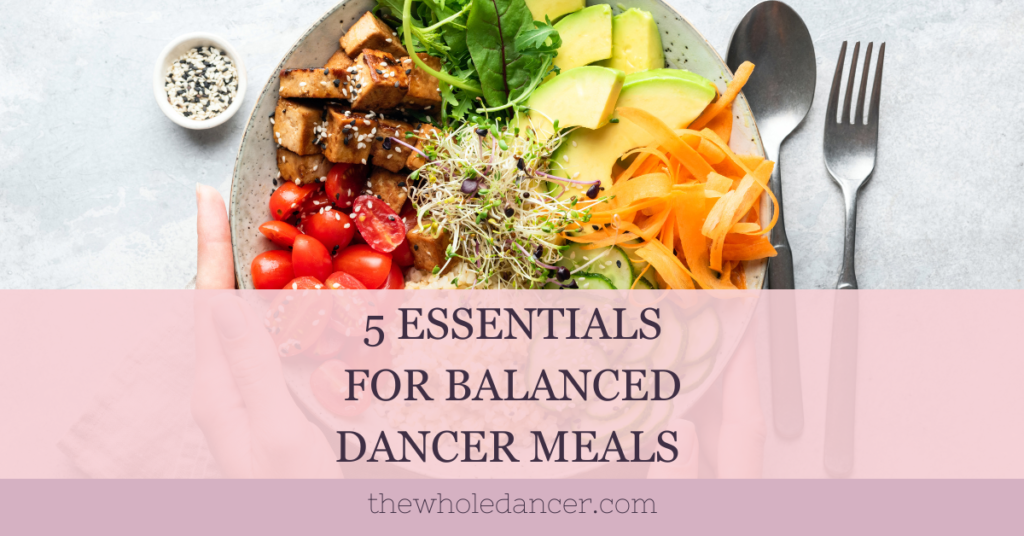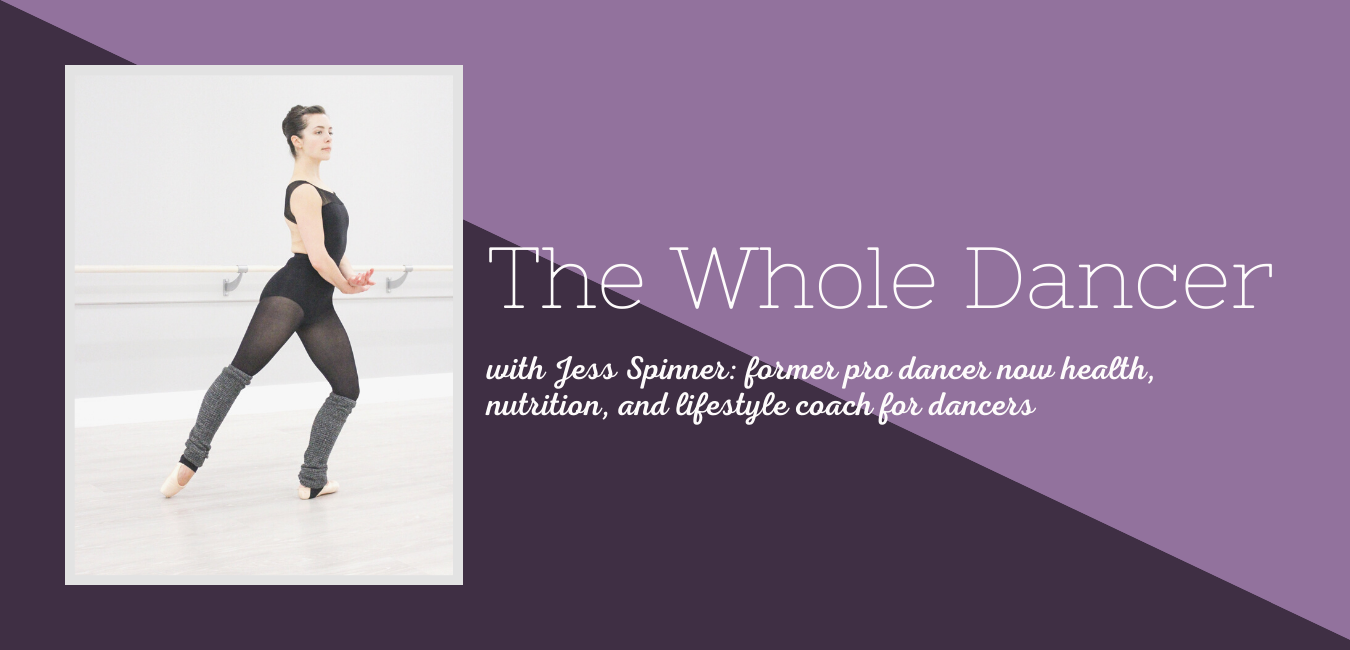In all the conversations I’ve had with dancers about food and nutrition over the last several years, there’s been a common theme. There is a lot of concern about fitting it all in and getting all the nutrients one needs to dance their best.This goal of achieving some pinnacle of nutrient-focused eating can lead to a full on disconnect from listening to one’s body. And many dancers want someone to “please just tell me exactly what to eat.” There’s also a perfectionism aspect that craves the “ideal” balance of nutrients to ensure optimal performance.
Fortunately, there is no perfect way to eat. The eating plan that’s best for you will be completely different from the dancer’s next to you. However, if you’re looking for guidelines, look no further. I’ve created a framework to help you find confidence in your food and meal choices.

The Whole Dancer Functional Five for Balanced Dancer Meals
First and foremost, you want to utilize whole foods often.
What exactly does whole food mean in this context?
The real stuff, food components that are as close as they can be to their natural state; whole grains, beans, legumes, fruit, vegetables, healthy fat, and protein for example.
Remember, this is just a guideline. Each and every dancer’s interpretation of The Whole Dancer Functional Five will look a little different!
At each meal (and most snacks) aim to include:
- Starchy Carbs
- Protein
- Fat
- Non-starchy carbs
- Joyful flavors
By including each of these five things, you’ll ensure that you’re getting your essential macronutrients, covering your micronutrient bases, and putting together meals you truly enjoy eating.
Starchy carbs for energy and joy.
These carbs provide you with energy and should be included in each and every meal. Starchy carbs also tend to be the more comforting carbs as they increase serotonin, our body’s feel-good chemical.
Starchy carbs are considered complex carbs and include many different types of foods. Potatoes and potato products are the starchy carbs that may spring first to your mind. But other so-called root vegetables — those that grow underground — also fall into this category, including sweet potatoes and yams, parsnips, jicama, taro root, water chestnuts, Jerusalem artichoke, and rutabaga. Carrots, beets, turnips, and daikon radishes contain starches, too, but less than other root veggies.
Winter squashes count as starchy carbs as well, including pumpkin, butternut squash, Hubbard squash, acorn squash and delicata. Corn, both on and off the cob, is also a starchy carb.
Beyond your starchy carb vegetables, also include grains and grain products, legumes, nuts, and seeds.
Protein for satisfaction and muscle repair and synthesis.
Many foods contain protein, and high-quality protein comes from beef, poultry, fish, eggs, milk and dairy products, soy and soy products. Including a variety of plant-based sources of protein, such as beans, nuts, and seeds throughout the day will also help to meet protein requirements.
Dancers need to remain aware that because of the ability to offer satiety, protein consumption needs to be mindful. You may need to prioritize more carbs in order to meet your energy needs for a day of dancing without getting too full.
Fat for fullness and hormone balance.
Dietary fat also plays a key role in helping individuals meet their energy needs as well as supporting healthy hormone levels. Healthy sources of fat include nuts, nut butters, avocados, and olive and coconut oils.
Fat might be something to incorporate into your “joyful tastes” as it’s a great option for a topping or sauce. You can easily create tahini, avocado, cashew, or oil-based sauces. Balanced dancer meals include fat.
Non-starchy carbs for volume and nutrients.
Do you ever feel like you’re snacking too much? This is actually quite a common feeling among dancers. I find many of my clients don’t have enough fat, protein, or volume (or sometimes all 3 are lacking) to meet their needs at a meal so they end up snacking to fill in the gaps.
Non-starchy carbohydrates don’t necessarily provide a substantial amount of energy. These carbohydrates are better known for their fiber, prebiotics, vitamins, and minerals.
When you hear non-starchy carbohydrates, think of greens, vegetables, fruits, and berries! These are your leafy greens like arugula, kale, and romaine as well as your veggies like brussels sprouts, bok choy, tomatoes, cucumbers, and many more.
Fruits include melons, berries like strawberries, raspberries, blackberries and blueberries, citrus fruits like oranges, tangerines, grapefruit and lemons, peaches, plums, apricots, cherries, and pears among others classify as non-starchy fruits.
All of these foods are also rich in fiber. Fiber is so important to any diet as it balances cholesterol levels in the blood, regulates bowel movements, regulates blood sugar levels, regulates your satiety levels, and aids in digestion overall.
These plants can make up a good portion of your plate. Their fiber and water content help to keep you full and provide your body with the nutrients you need to support healthy digestion.
Joyful flavors so you truly love all the food you eat.
If you’re struggling to enjoy healthy, whole foods, it’s very likely you’re missing the flavor factor. You should never have to force yourself to eat something. You can enhance the taste of your food with sauces, seasonings, and different cooking methods.
Herbs and spices are delicious but they’re also rich in antioxidants, which protect your cells from free radicals. There’s a strong body of evidence that spice consumption can reduce or even eliminate the harmful effects on humans from contaminants in foods and from the environment.
When you cook, include cloves, oregano, rosemary, cinnamon, thyme, turmeric, sage, and more so you look forward to enjoying your healthy meals.
Need guidance to start to incorporate the functional five for more balanced dancer meals? Explore Elite Best Body Coaching and sign up for your complimentary coaching call today.

Pingback:Dancer Nutrition Mistakes to Avoid - The Whole Dancer
Pingback:The Whole Dancer Plate - The Whole Dancer